A Guide to Greenfinches
Greenfinches might not have the range of colours of their Goldfinch cousins, but they are still have a spectacular plummage. They are also viewed as one of the best starter birds you can buy by many aviary keepers because they tend to be fairly hardy, have a good song, and don’t have any specific needs that require the management of an experienced keeper.
In this blog, we take a look at the humble Greenfinch to find out what they are like in the wild and as pets to find out if they are the right choice for your aviary.
Appearance
Unsurprisingly, the European Greenfinch get its name from its colour. The males have predominantly green plumage with yellow in the tails and their wings. The females and juveniles are more drab, however, with a duller green brown plumage and brown colouring on their backs.
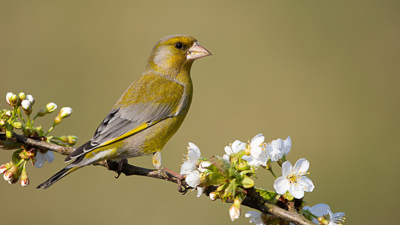
They stand around 14-16cms high (5.5 – 6.3 inches), weight between 25g and 28g, and have a wingspan of around 24.5-27.5cm (10-11 inches).
A particular characteristic of Greenfinches is their bill. They have a thick, conical bill that they use to crack open hard seed shells which make up a significant part of their diet in the wild.
Do Greenfinches Sing?
One of the things that have made Greenfinches so popular, both in the wild and as an aviary bird, is their song. The have a loud, high-pitched, rapid, twittering, chirping, joyful song that cannot help but bring a smile to your face when you hear it.
The songs and calls of the males and females are hard to tell apart. Males sing far more readily than females though, often starting as early as January and producing a complex swirl of phrases and melodies designed to attract a mate.
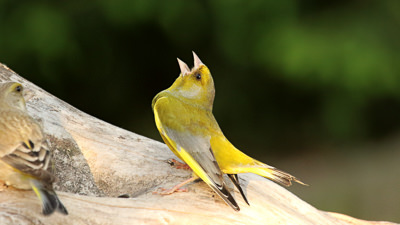
Their songs consist of rapid chichichi sounds interspersed with longer notes, sometimes described as dzweeeee, and these will be repeated until he stops and listens for a reply. Male Greenfinches will sit at the top of a tree or bush to sing from an elevated position as this ensures their songs project further and is one of the reasons they sound so loud for such a small bird.
If you want to hear it, head over to our Spotter’s Guide, where you can hear the songs of all your favourite birds. You can find it here https://johnstonandjeff.co.uk/spotters-guide-to-wild-birds/.
What do Greenfinches Eat?
As with all aviary birds, to get an in depth understanding of their dietary requirements, it is important to look at what their wild counterparts eat.
As mentioned above, their bill is a big give away to the main component of their diet. Greenfinches love seeds and their bill is specifically adapted to be able to crack open hard-cased seeds and get to the good stuff inside.
However, they will also take berries, nuts, and eat insects and feed them to their young, making for a varied diet in the wild.
If you want to encourage Greenfinches to your garden, or you keep Greenfinches in an aviary, individual ingredients such as sunflower seeds, sunflower hearts, peanuts, dried mealworms, Dried Calciworms, peanut granules, and suet products, are great for them.
Niger seeds are also a firm favourite with finches.
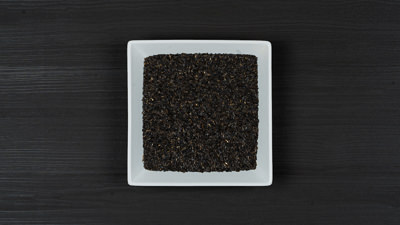
Blended feeds are also good for Greenfinches, providing high quality, balanced nutrition if you choose the right ones. They love our No Mess, No Grow Wild Bird Food, High Energy No Mess, and Selected, Superior and Premium Wild Bird Food.
Speciality mixes are great for feeding Greenfinches too, such as our Goldfinch Mix and Robin & Songbird.
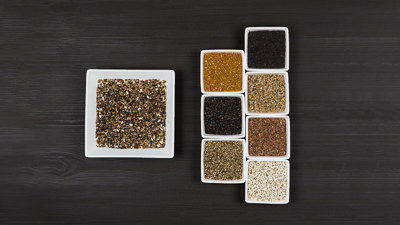
In fact, with the varied diet Greenfinches enjoy, many of our individual foods and blends are loved by them – more than we can list here – so why not go and check out the different foods they can eat by visiting our Blends and Treats page and clicking on Greenfinch?
One thing to mention though, is wild Greenfinches have a reputation for squabbling with other birds at the feeder or bird table, so if they do come to your garden, you’ll be sure to hear them!
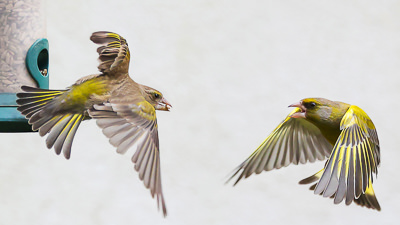
For those people who keep Greenfinches as avian birds, we have a special mix which has been thoughtfully designed for larger finches call Bullfinch & Greenfinch. Seed for Soaking and British Finch Mix are also loved by Greenfinches. To find out more about them, click here https://johnstonandjeff.co.uk/aviary-match-species-to-blends/.
Nesting Behaviour
Whereas they’re not particularly social birds that form flocks, Greenfinches do nest in loose colonies, generally in dense evergreen shrubs or hedges which provide the perfect, safe environment in which to build their nests and raise their young.
They begin nest building in late March or early April and they use twigs, moss and grass in its construction. However, they don’t build intricate nests with interwoven materials like other birds do, and are more concerned with location – dense vegetation to protect against predators – than construction.
They vacate the nest in August when the breeding season has ended and never return to it, instead building a new one every year.
Females lay four to five eggs per clutch and often have two or three clutches per year. The eggs are incubated for 14 – 15 days and the chicks leave the nest at around 15 days old.
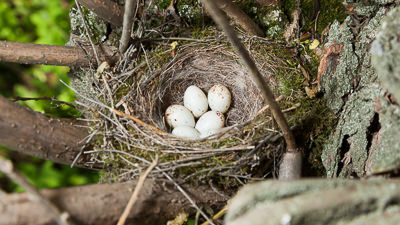
If you want to encourage Greenfinches to nest in your garden, it is better to leave shrubbery or hedges untrimmed than it is to put up nest boxes. Not being cavity nesters, it is very rare to find a Greenfinch in a nest box.
However, because they prefer dense vegetation to protect their young against predators, it is unlikely they will nest in your garden if you routinely trim your shrubs and hedges back. So, if you really want to encourage Greenfinches to nest in your garden, you must leave some dense vegetation.
Trichomonosis
It would be impossible to talk about Greenfinches without mentioning Trichomonosis, a disease that has sadly brought about a significant decline in Greenfinch numbers since the 1990s.
The disease is a parasite which is deadly to birds but poses no risk to humans or mammals.
The parasite, full name Trichomonosis gallinae, infects the tissue around the bird’s mouth, throat and oesophagus, making it difficult for it to eat and breathe. Although many species of bird can be affected, Chaffinches and Greenfinches have been worst hit with the population of the latter having dropped by around 63% since 1993 when the first cases were reported in the species.
However, there is hope. A 2022 bird count that involved more than 700,000 people across the UK reported a small increase in Greenfinch populations for the first time in many years, a trend which will hopefully continue.
People who feed the birds in their garden can do their bit to prevent the spread of this awful disease. It is passed on via contaminated food and drinking water which means the transmission can be slowed if garden owners clean their feeders, bird tables, and drinking vessels on a regular basis with bird-friendly detergents that are effective against the parasite.
For full instructions on how to thoroughly clean bird tables and feeders, check out our blog here.
Greenfinches as Pets
If you’re considering starting an aviary but don’t have much experience of keeping birds, Greenfinches are often regarded as a great species to choose. This is because they are relatively hardy birds that don’t require any specialist form of care or management, and, as we saw above, their varied diet means they are plenty of great feeds on the market they will enjoy and will keep them healthy.
Here at Johnston & Jeff, we have a range of feeds that are well suited to kept Greenfinches, including British Finch, our Seed for Soaking, and our species specific mix, Bullfinch & Greenfinch.
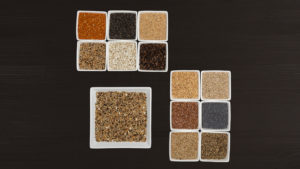
Obviously, it is illegal to catch finches to keep as pets nowadays, so to start your aviary, you will have to locate an experienced breeder and buy a bird from them.
One question we are frequently asked is should you keep Greenfinches in pairs. The answer is yes. It is not fair to keep a single finch of any type because it will not be happy alone. So, the minimum you should keep is two.
If you’re starting your aviary with a pair, then they are best kept as a cock and hen pair. Single birds should not be added to an aviary until you have at least three cock/hen pairs as a not to disrupt the existing birds. Even with three or more cock/hen pairs, a single male birds may cause confrontation while vying for the attention of the females in the aviary, so this may need to be managed.
In all other respects, managing Greenfinches as aviary birds should be done along the lines of any other species. Aviaries must be kept clean, particularly with the threat of Trichomonosis, as must all feeding and drinking equipment. Fresh food and water must be provided every day, and perches must be provided to give the birds a place to sit.
The aviary must of course be predator proof and provide shelter from inclement weather.
If you have any questions about keeping Greenfinches or what to feed them for optimum health and happiness, don’t hesitate to get in touch.
Our recent posts giving advice and guidance on wild birds
Ground Nesting Birds
Ground Nesting Birds In an earlier article, we looked at nesting behaviour in wild birds and how you could use this knowledge to encourage birds to nest in your garden. In that article we talked about birds that nest in [...]
Incredible Journeys – Bird Migration Explained
Reading Time: 11 minutes While many species of bird make the UK their home all year round, some just visit for the summer or winter months and then head off to distance shores for the rest of the year. In this blog, we examine bird migration, taking a deep look into one of nature’s most spectacular phenomena to find out more about what makes it possible.
A Guide to Greenfinches
Reading Time: 9 minutes Greenfinches might not have the range of colours of their Goldfinch cousins, but they are still have a spectacular plummage. They are also viewed as one of the best starter birds you can buy by many aviary keepers because they tend to be fairly hardy, have a good song, and don’t have any specific needs that require the management of an experienced keeper.



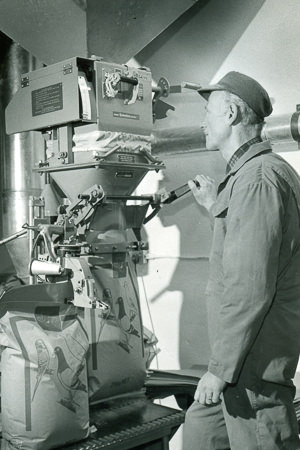




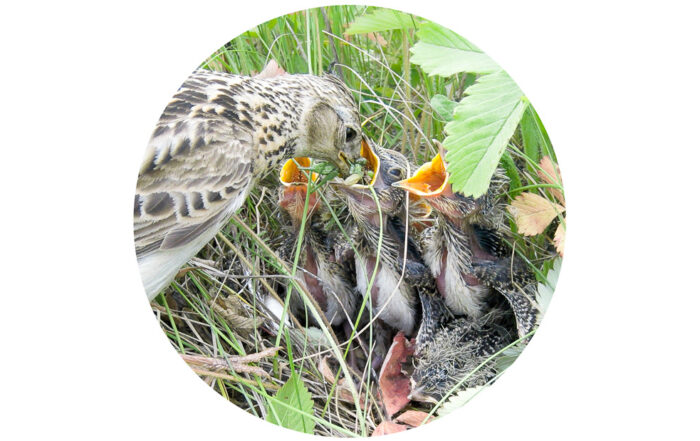
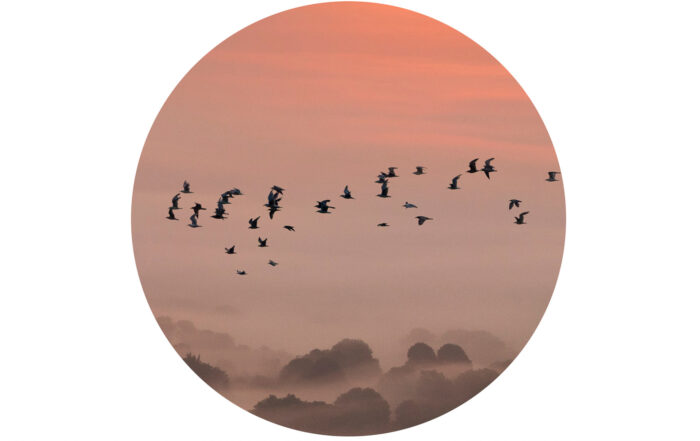
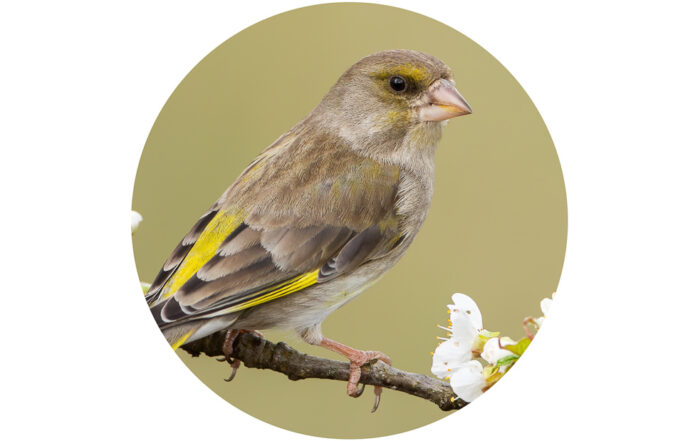
Leave A Comment